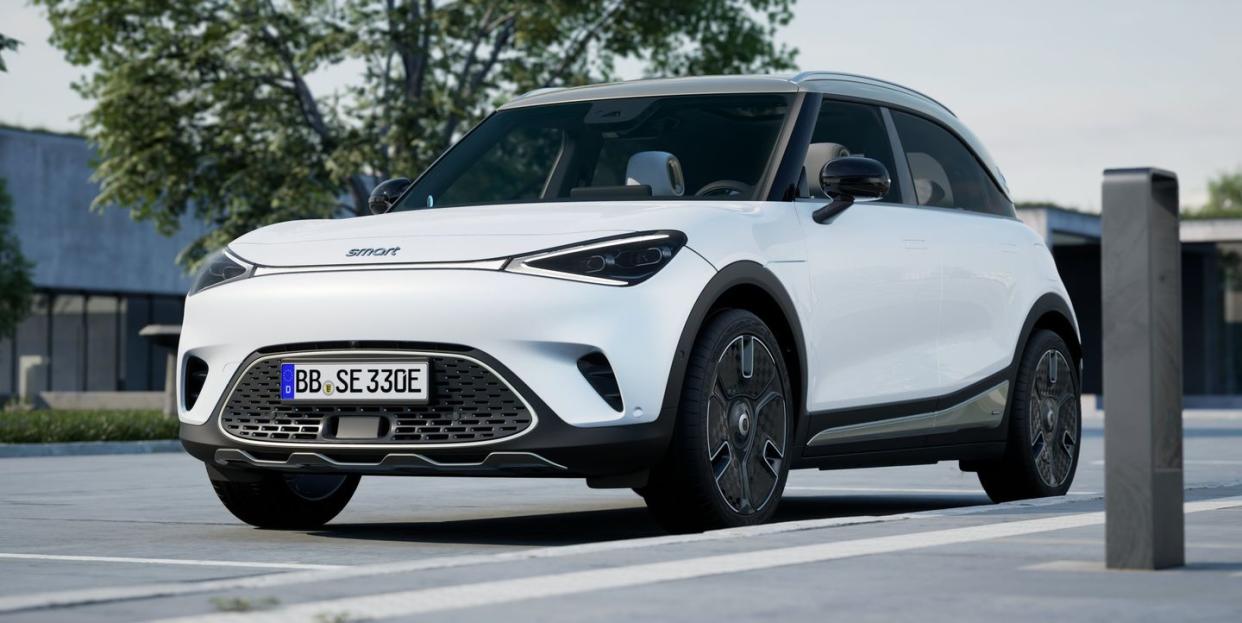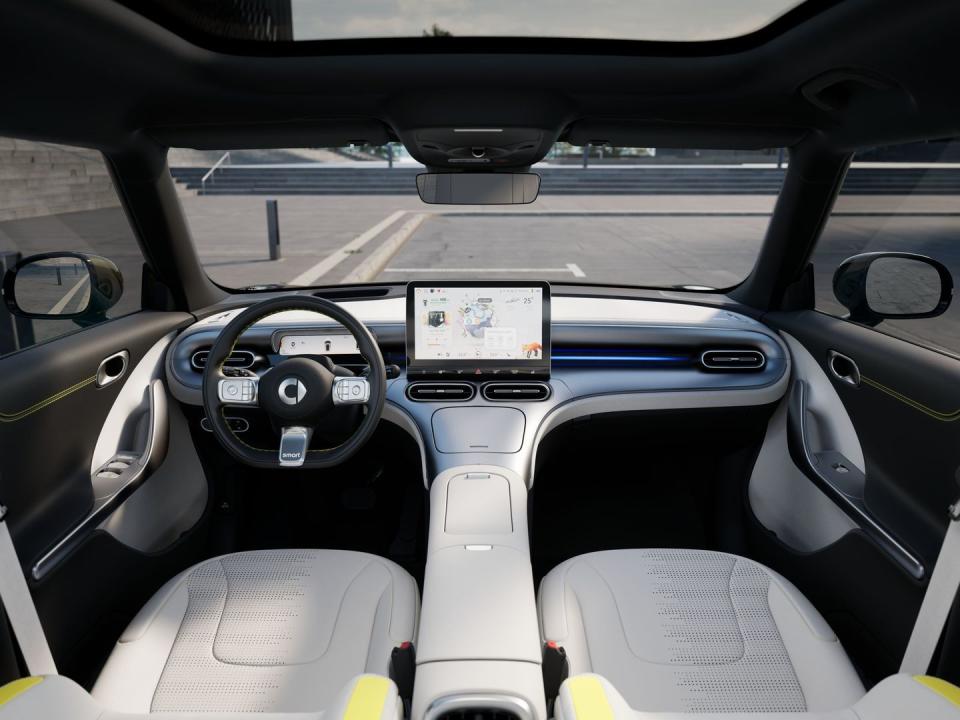After All Those Smarts We Didn’t Buy, Here’s One We Might (but Can’t)

The cutesy Smart #1 EV crossover combines decent performance with excellent refinement
The diminutive electric car will be available in both rear-drive- and all-wheel-drive versions, the latter with Brabus branding.
On sale in Europe and China next year, the Smart #1 won’t come to US.
European automakers clearly have a thing about both unlikely capitalization of model names and attempts to introduce punctuation. Buyers on the other side of the Atlantic can already choose a Volkswagen up! and until recently could have a Kia Pro_Cee’d, although the most recent generation has been simplified to ProCeed. But Smart is breaking new boundaries with the #1. That’s right, this really is the “Hashtag One.”
The name is silly but the car it is attached to, an EV crossover, is pretty sensible—although there seems very little chance it will ever reach the US. Smart withdrew from the States in 2019 on the back of our near total indifference to its miniature Fortwo city car, and we’re told there are no plans for the brand to return. In Europe the Fortwo is also set to die soon, with Smart becoming a joint venture between original corporate parent Mercedes-Benz and Chinese automaker Geely, the same group that owns Volvo, Polestar, Lotus, and minority stakes in both Mercedes parent Daimler and, as of last week, also Aston Martin.
The #1 is the first product from this new partnership, sitting on Geely’s SEA pure electric architecture and set to be built in Xi’an in China’s Shaanxi Province. It will be sold in both China and Europe, with Autoweek driving it at the international media launch in Lisbon, Portugal.

At 168.1-inches in length, the #1 is much bigger than a Fortwo, but still at the smaller end of the compact crossover class, being just 2.5-inches longer than the Hyundai Kona EV. And while there isn’t any obvious DNA from previous Smart models in the exterior styling—which has been done by Mercedes—it does look both handsome and distinctive up close. The full-width rear light bar has a definite family resemblance to the Mercedes EQB, though.
All versions of the #1 will use an underfloor battery pack with 64 kWh of capacity, with this turning either a single rear motor or a pair that send power to each corner. The rear-drive version boasts 268 hp and is claimed to be capable of getting from 0-62 mph in 6.7 seconds, while the AWD version—which carries Brabus branding—has a peak of 422 hp and an official 3.9-second 0-62 mph time.
While no previous Smart product has been famed for interior space, the #1 finds an impressive quantity of cabin volume considering its compact dimensions; full-sized adults can sit behind each other without either front or rear feeling cramped. It’s well finished, too, with quality materials and details that include subtle LED illumination in both door panels and even integrated into the metal dashboard air vents. Space efficiency is diminished by the size of the substantial console that sits between the front seats, this incorporating various storage and charging compartments—and also by the tininess of the 11 cu-ft trunk. There is also an even more bijou 0.5 cu-ft frunk under the hood.

As with most EVs, there is little conventional switchgear, although the bottom margin of the central 12.8-inch high definition touchscreen is always reserved for climate functions. Both the test cars I drove suffered from an lighting imbalance, with this screen being darker than the digital instruments even when the brightness turned fully up. But the bigger problem was the UI system, which felt unfinished to the extent of having syntax and spelling errors in many of its menus. Although Geely brands Volvo and Polestar both use Android Automotive as their native operating systems, Smart uses a refaced version of Geely’s considerably less slick ECARX system. This features a cutesy animated character, a fox which prowls through menus and sub-menus, but it completely lacks the Android Auto or Apple CarPlay integration that the sort of young, tech-minded buyers Smart is aiming the car at will doubtless expect to find as standard.

Although less powerful, the rear-driven #1 impresses much more than the AWD Brabus version. The single motor gives keen acceleration, especially at urban speeds, and also proved willing to cruise happily on Portugal’s toll highways at an indicated 85 mph, the cabin staying quiet and hushed as it did. Smart says ultimate performance is limited by a 112-mph speed limiter, but it’s hard to imagine too many owners ever finding this a hindrance.
Lacking adaptive dampers, despite a chunky 3940-lb weight, the #1’s switchable dynamic modes only adjust throttle mapping, regeneration levels, and the weighting of the steering. I noticed a very slight delay to the gas pedal’s responses, less than half a second but enough to mean that any sudden requests for acceleration tended to arrive with a bump. But soft chassis settings soon made it clear the Smart has been designed for gentle progress, the ride staying pliant despite standard 19-inch alloys, although at the cost of a little float developing over rough surfaces.

It lacks much in the way of enthusiasm. The steering can’t muster much in the way of feel, and efficiency-rated Continental EcoContact 6 tires were similarly deficient in front-end bite. Pushing harder soon resulted in a surprising amount of discernible roll for an EV with its mass mounted so low and then an ungainly amount of understeer. (A trait the Fortwo also shared, to be fair.) But the active cruise control with lane keeping assistance worked well and the regenerative braking blended cleanly with friction retardation, although the switchable one-pedal mode only brought a very gradual level of slowing.
The all-wheel driven Brabus is, as you’d expect, faster and more exciting—but much less disciplined. Apart from stiffer springs to take account of the extra 247-lb mass brought by the front motor, and a new Brabus dynamic mode, the chassis is barely changed. The ride height is the same, as are the EcoContact tires which, predictably, struggle when asked to deal with getting on for twice as much power. The Brabus is certainly quick in a straight line, and there’s a compelling novelty to the idea of what looks like a mall rat crossover capable of blowing away sharp-end supercars off the line. But in corners it felt well out of its depth, with both ends of the car seeming to fight each other under power to see which one can give up first. It felt like a car crying out for stiffer springs and stickier tires.
The rear-driven #1 also goes further on a charge, with its battery pack claimed to be capable of delivering 273 miles of range under the generally optimistic European WLTP testing protocol; the Brabus manages 248 miles. Both support DC fast charging at rates of up to 150 kW, and all but the most basic rear-drive version will allow 22-kW AC charging.
Are we missing out? The limited enthusiasm of US buyers for the Smart Fortwo across two generations means we can’t really blame the brand for not wanting to throw the dice on a relaunch. But beyond its borderline #tragic name, the #1 does feel like a car that in terms of shape and size is much better suited to American tastes than its predecessors, with the bonus of a potent and well-engineered EV driveline.
Would you like to see Smart cars return to the United States in this all-electric form? Or do you think Smart failed here once, it’d just fail again? Share your thoughts in the comments below.

